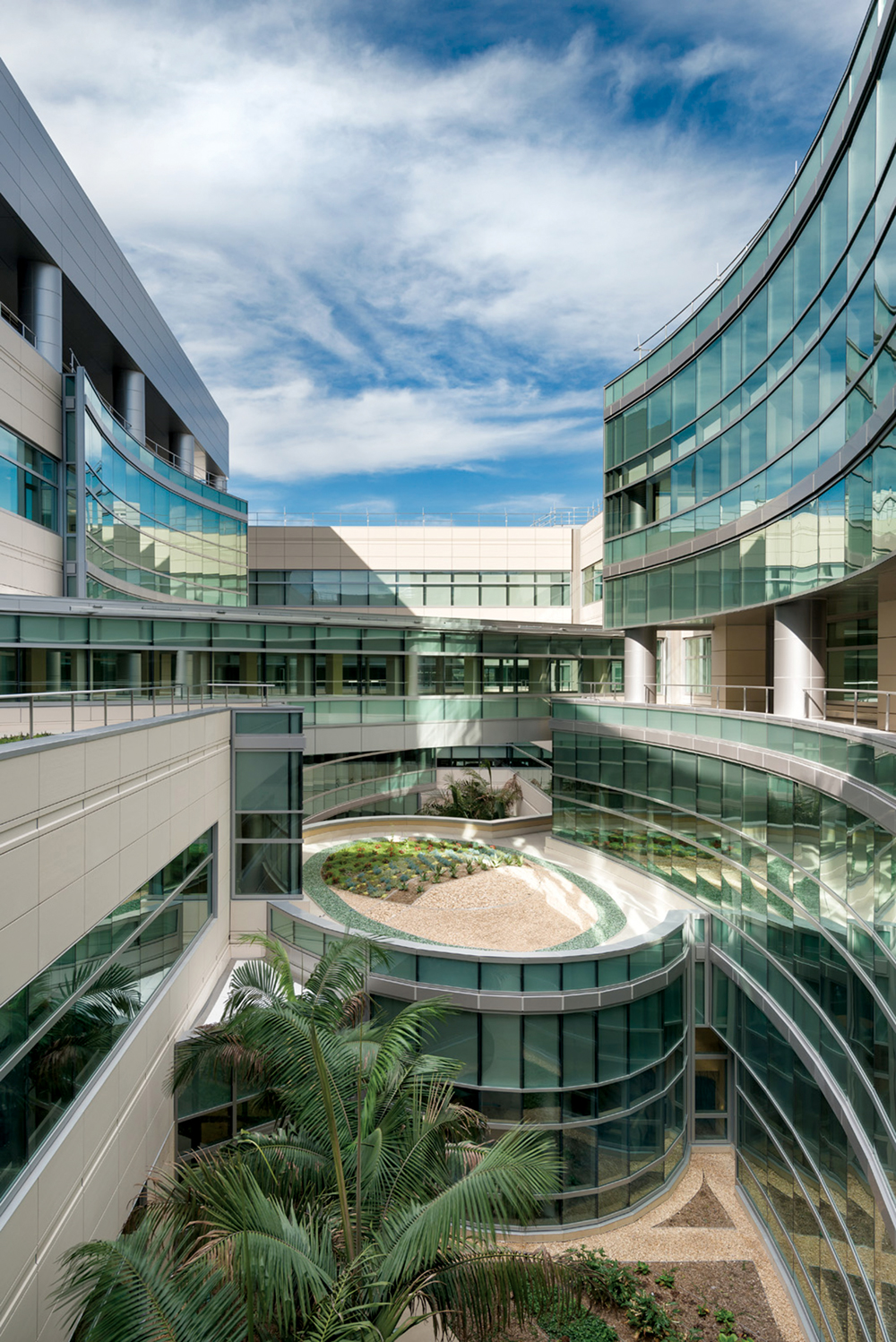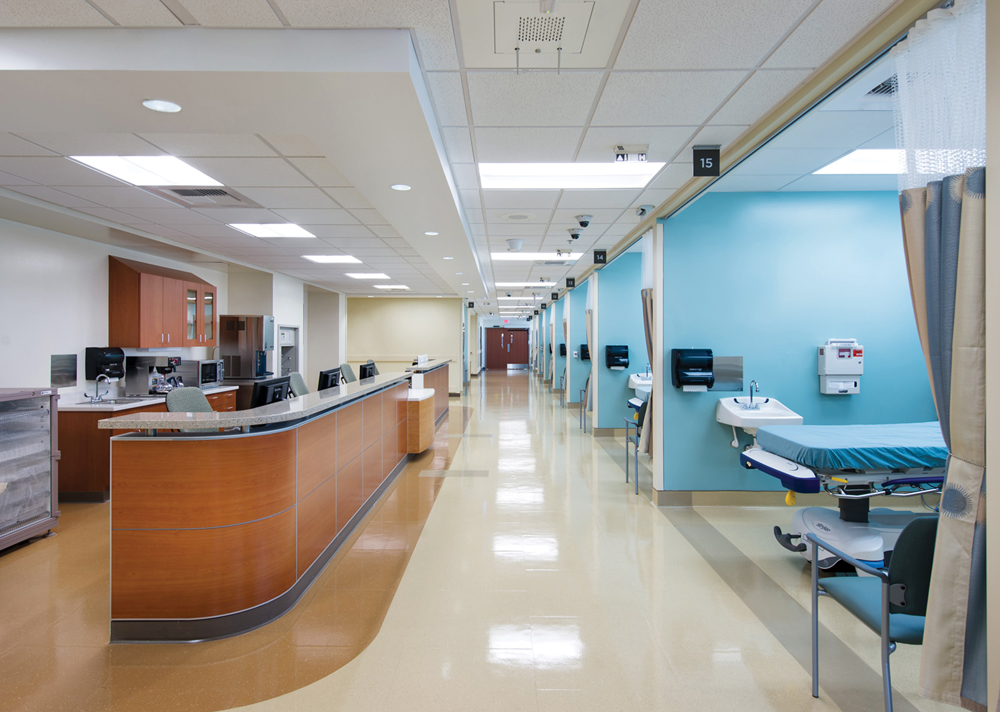In a Building Team Awards competition that was heavy with high-quality healthcare projects, including four eventual winners, the Naval Hospital at Camp Pendleton (NHCP) stood out, according to the awards judges. The jury commended the Building Team for executing an extremely large and complex program under an aggressive schedule and experimental design-build contracting method—all while beating the initial budget by nearly 19%.
“On top of that, this project has a strong environmental story,” said Building Team Awards judge Susan Heinking, AIA, NCARB, LEED AP EB O+M, Sustainability Leader and Vice President with VOA. On track for LEED Gold, the facility outperforms baseline ASHRAE energy standards by 30%, thanks to its daylight-rich interior scheme, 36,000-sf vegetated roof, and 170 kW photovoltaic solar panel array for domestic hot water.
The massive, one-million-sf campus was completed in just 34 months, a full six months ahead of the original schedule and two years faster than any previous NAVFAC hospital project. The Building Team also came in more than $100 million under budget, with less than 2% contractor-requested change orders, zero lost-time incidents, and zero rework needed due to government noncompliance.
The scope of the project entailed building a 500,000-sf hospital with 60 inpatient beds for medical surgery, labor/delivery, post-partum, and intensive care, as well as 96 procedure rooms, 205 exam rooms, and 10 operating rooms; a central utility plant with 3,100 tons of cooling and redundant utility systems; a 1,500-space parking facility; and 1,000 surface parking spaces.
PLATINUM AWARD
Project summary
Naval Hospital at Camp Pendleton
Oceanside, Calif.BUILDING TEAM
Submitting firms: Clark Construction Group, McCarthy Building Cos. (joint venture design-build contractor)
Owner: NAVFAC Southwest
Design architect: HDR Architecture
Architect of record: HKS
Interior architect: Young and Co.
Structural engineer: KPFF Consulting Engineers
Mechanical engineer: TMAD Taylor and Gaines
Electrical engineer: exp.
Civil engineer: BergerABAMGENERAL INFORMATION
Size: 1,000,000 gsf
Construction cost: $447.3 million
Construction: September 2010 to September 2013
Delivery method: Design-build
Funded through the American Recovery and Reinvestment Act of 2009, the project had to be completed in record time (by Navy standards) in order to meet the ARRA requirements. It meant the Building Team would have to compress the project schedule from the typical five- to seven-year time frame to just 40 months—a goal that was ultimately bested by six months.
To expedite the schedule and start construction early, the project team developed a phased-design approach—a first for NAVFAC. The team worked alongside the client to identify critical path activities available for early starts, and eventually divided the project into six design packages.
This approach slashed several weeks off the project schedule. For instance, by sequencing the structural package as one of the first to be reviewed and approved, the hospital’s foundation work kicked off two weeks early. And siphoning a portion of the civil design into an early package facilitated the relocation of two high-voltage transmission lines, which enabled the team to clear the way for an early start of mass grading.
BREAKTHROUGH TURNKEY PROJECT DELIVERY
In a first for the federal government, the design-build team, under a turnkey contracting method, was responsible for not only designing and building the campus, but planning, procuring, and installing all medical equipment, furniture, and artwork, as well as training the hospital staff on the equipment. From the MRI units and blood analyzers to the patient beds and operating room integration, the Building Team was responsible for all aspects of delivery: design, planning, equipment selection, procurement, installation, training, and warranties.
Under the contract, the design-build team—led by Clark Construction Group and McCarthy Building Cos., with HDR Architecture and HKS on the design side—worked hand in hand with NAVFAC to evaluate, select, and coordinate more than 20,000 pieces of equipment for the complex. Every piece of equipment was scrutinized to determine the greatest value to the client, based on life cycle cost, maintenance contracts, model options, and competitive offerings.

The massive campus was completed in just 34 months, a full six months ahead of the original schedule and two years faster than any previous NAVFAC hospital project. A pocket courtyard adds to the healing environment. Photo: LaCasse Photography
Once the design was finalized, the team worked closely with NAVFAC to understand its funding schedule, and with the equipment manufacturers to develop a procurement schedule. The goal was to delay final equipment selections to ensure the latest technology, without impacting construction or requiring rework. After the client settled on specific equipment, Clark/McCarthy secured a purchase order from the manufacturer, coordinated lead times with the construction schedule, and incorporated just-in-time delivery to the site, which eliminated the need for temporary warehousing.
5D BIM MODEL PAYS OFF
From the project’s inception, the team worked entirely in three dimensions to design and coordinate the hospital, including its civil infrastructure, building superstructure, envelope, building systems, and interior spaces.
During design development, the model helped the team accurately determine the budget and constructability. The model was linked to the project’s cost-loaded CPM schedule to produce a 5D tool (3D geometry, time, cost) that automatically adjusted when changes were made.
Using the model, the team prefabricated numerous materials and components, including mechanical systems, window and exterior framing assemblies, ductwork, piping, casework, pneumatic tube system, and electrical distribution systems.

Navy Medicine West personnel were integrated into the project team to provide valuable counsel on how to design and build the most functional spaces for hospital staff. The team used BIM to produce virtual mockups, in conjunction with physical mockups, for a half-dozen major medical spaces. The digital layouts helped coordinate all in-wall and overhead MEP and mechanical spaces, doors, and stud locations, as well as provide tools for early validation by the clinical staff. Photo: LaCasse Photography
From the successful implementation of an experimental turnkey contract method to the use of 5D BIM for advanced collaboration, the Naval Hospital at Camp Pendleton will serve as model for federal healthcare facilities delivery for years to come.
Related Stories
Sports and Recreational Facilities | Mar 14, 2024
First-of-its-kind sports and rehabilitation clinic combines training gym and healing spa
Parker Performance Institute in Frisco, Texas, is billed as a first-of-its-kind sports and rehabilitation clinic where students, specialized clinicians, and chiropractic professionals apply neuroscience to physical rehabilitation.
Market Data | Mar 14, 2024
Download BD+C's March 2024 Market Intelligence Report
U.S. construction spending on buildings-related work rose 1.4% in January, but project teams continue to face headwinds related to inflation, interest rates, and supply chain issues, according to Building Design+Construction's March 2024 Market Intelligence Report (free PDF download).
Apartments | Mar 13, 2024
A landscaped canyon runs through this luxury apartment development in Denver
Set to open in April, One River North is a 16-story, 187-unit luxury apartment building with private, open-air terraces located in Denver’s RiNo arts district. Biophilic design plays a central role throughout the building, allowing residents to connect with nature and providing a distinctive living experience.
Sustainability | Mar 13, 2024
Trends to watch shaping the future of ESG
Gensler’s Climate Action & Sustainability Services Leaders Anthony Brower, Juliette Morgan, and Kirsten Ritchie discuss trends shaping the future of environmental, social, and governance (ESG).
Affordable Housing | Mar 12, 2024
An all-electric affordable housing project in Southern California offers 48 apartments plus community spaces
In Santa Monica, Calif., Brunson Terrace is an all-electric, 100% affordable housing project that’s over eight times more energy efficient than similar buildings, according to architect Brooks + Scarpa. Located across the street from Santa Monica College, the net zero building has been certified LEED Platinum.
Museums | Mar 11, 2024
Nebraska’s Joslyn Art Museum to reopen this summer with new Snøhetta-designed pavilion
In Omaha, Neb., the Joslyn Art Museum, which displays art from ancient times to the present, has announced it will reopen on September 10, following the completion of its new 42,000-sf Rhonda & Howard Hawks Pavilion. Designed in collaboration with Snøhetta and Alley Poyner Macchietto Architecture, the Hawks Pavilion is part of a museum overhaul that will expand the gallery space by more than 40%.
Affordable Housing | Mar 11, 2024
Los Angeles’s streamlined approval policies leading to boom in affordable housing plans
Since December 2022, Los Angeles’s planning department has received plans for more than 13,770 affordable units. The number of units put in the approval pipeline in roughly one year is just below the total number of affordable units approved in Los Angeles in 2020, 2021, and 2022 combined.
BIM and Information Technology | Mar 11, 2024
BIM at LOD400: Why Level of Development 400 matters for design and virtual construction
As construction projects grow more complex, producing a building information model at Level of Development 400 (LOD400) can accelerate schedules, increase savings, and reduce risk, writes Stephen E. Blumenbaum, PE, SE, Walter P Moore's Director of Construction Engineering.
AEC Tech | Mar 9, 2024
9 steps for implementing digital transformation in your AEC business
Regardless of a businesses size and type, digital solutions like workflow automation software, AI-based analytics, and integrations can significantly enhance efficiency, productivity, and competitiveness.
Office Buildings | Mar 8, 2024
Conference room design for the hybrid era
Sam Griesgraber, Senior Interior Designer, BWBR, shares considerations for conference room design in the era of hybrid work.

















